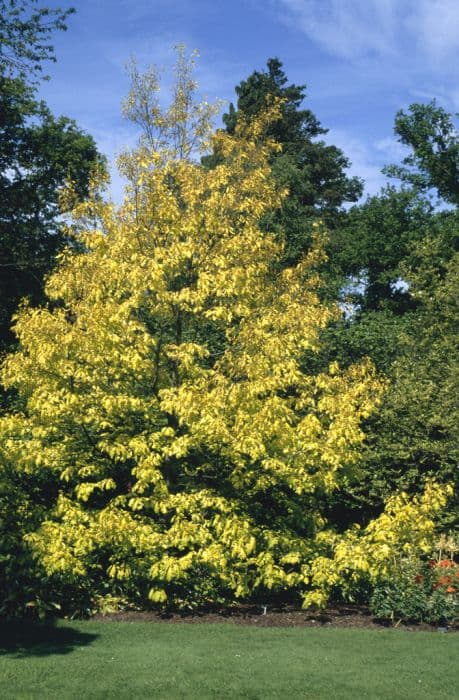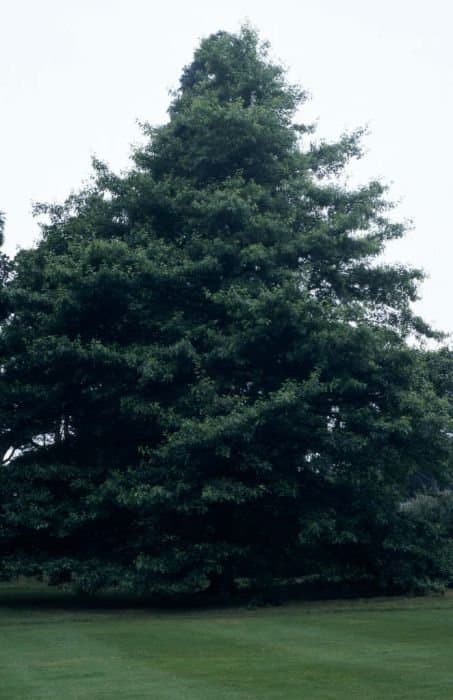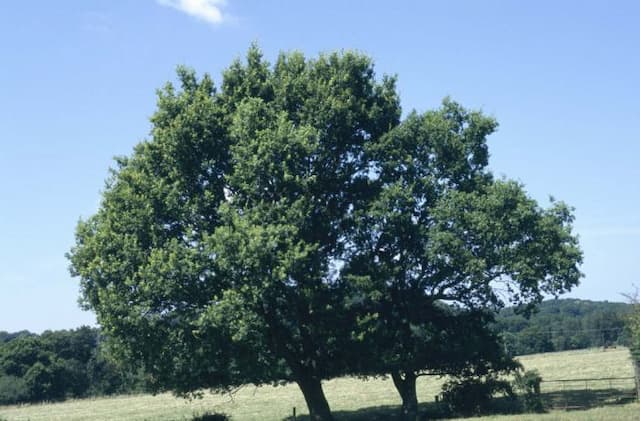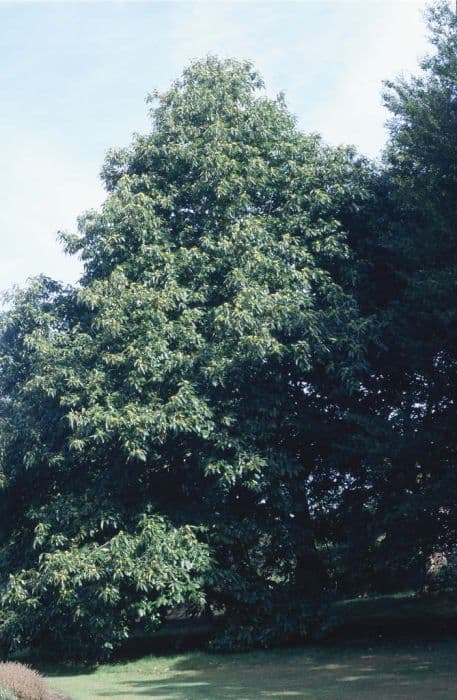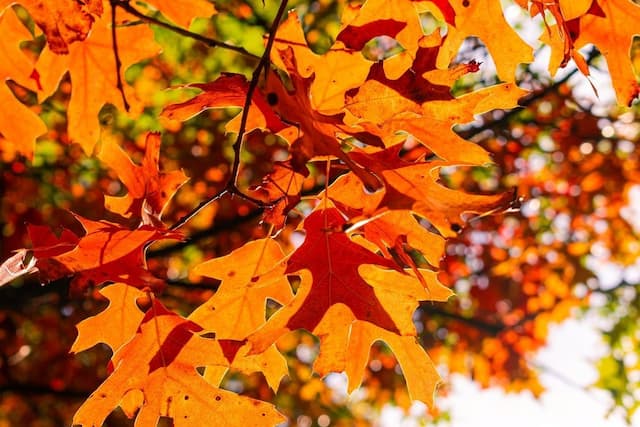Turkey Oak Quercus cerris
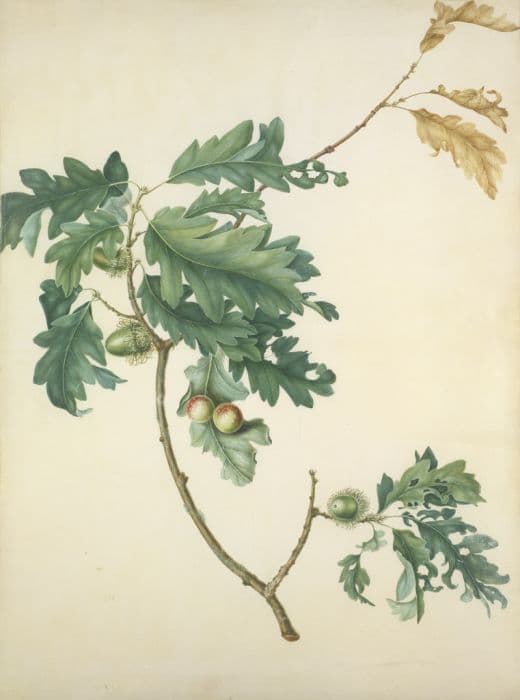
ABOUT
Quercus cerris, commonly known as the Turkey oak, is a deciduous tree known for its distinctive features. It has a robust and intricate branching structure, giving it a rugged appearance. The leaves of the Turkey oak are quite variable; they are typically lobed with pointed tips and can have a glossy dark green color on the top surface, while the underside is often paler with a fluffy texture. In autumn, the leaves can turn to a range of colors from yellow to a rich brown before falling off. The bark of the Turkey oak is another characteristic feature, as it is deeply grooved and has a rugged texture. Younger trees have a smoother bark which becomes craggier as they mature. The acorns, which are the fruit of the Turkey oak, are notable for their lengthened and slightly hairy cups that enclose about one-third to one-half of the nut. The acorns are an important food source for the wildlife that inhabit the area surrounding the Turkey oak. The male flowers of the Turkey oak are present in the form of catkins, which are elongated clusters that dangle from the branches in spring. In contrast, the female flowers are much less conspicuous and will develop into acorns after pollination. Overall, the Turkey oak is a significant species with unique aesthetic and ecological value.
About this plant
 Names
NamesFamily
Fagaceae.
Synonyms
Turkey Oak, Austrian Oak, European Turkey Oak.
Common names
Cerris australis, Cerris lanuginosa, Quercus australis, Quercus austriaca, Quercus brondelii, Quercus lanuginosa, Quercus worleii, Quercus zoufaliana.
 Toxicity
ToxicityTo humans
The common name for Quercus cerris is Turkey oak. This species of oak, like many others, contains tannins which can be toxic when ingested in large quantities. In general, oak trees are not typically eaten by humans, but incidents of poisoning can occur if large amounts of oak leaves or acorns are consumed. Symptoms of oak poisoning are generally related to gastrointestinal distress, including stomach pain, nausea, vomiting, and constipation. Kidney damage can also occur in severe cases due to the effects of tannic acid.
To pets
The common name for Quercus cerris is Turkey oak. Like most oaks, the Turkey oak is potentially toxic to pets such as cats, dogs, and horses if they ingest parts of the plant, such as acorns or leaves. These parts contain tannins which can cause gastrointestinal upset, leading to symptoms like vomiting, diarrhea, abdominal pain, and decreased appetite. In more serious cases, ingestion can cause kidney damage or failure, particularly in pets that consume large quantities of the plant material. Owners should prevent access to oak trees to avoid possible poisoning in their pets.
 Characteristics
CharacteristicsLife cycle
Perennials
Foliage type
Deciduous
Color of leaves
Green
Height
50-70 feet [15-21 meters]
Spread
50-70 feet [15-21 meters]
Plant type
Tree
Hardiness zones
6
Native area
Europe
Benefits
 General Benefits
General Benefits- Wildlife habitat: Quercus cerris, commonly known as the Turkey oak, provides shelter and nesting sites for various wildlife species.
- Food source: The acorns produced by the Turkey oak are a food resource for birds and mammals.
- Soil stabilization: The robust root system helps to prevent soil erosion and stabilizes slopes.
- Shade and cooling: The tree offers shade in landscaped areas, reducing local temperatures and providing relief during hot weather.
- Aesthetic appeal: With its distinctive bark and leaf shape, the Turkey oak adds visual interest to natural landscapes and parks.
- Carbon sequestration: As a large tree, it captures and stores carbon dioxide, contributing to the mitigation of climate change.
- Biodiversity support: The tree supports a range of organisms, including insects and fungi, which contributes to ecosystem diversity.
- Cultural significance: In some regions, Turkey oak has historical importance and adds to the cultural landscape.
 Medical Properties
Medical PropertiesThis plant is not used for medical purposes.
 Air-purifying Qualities
Air-purifying QualitiesThis plant is not specifically known for air purifying qualities.
 Other Uses
Other Uses- Tanning Leather: The high tannin content in the bark of the Turkey oak can be used in the leather tanning process to create durable and high-quality leather goods.
- Ink Production: Historically, the galls produced by insects on the Turkey oak were used in the production of iron gall ink, which was a staple for writing and drawing for centuries.
- Woodworking: The wood of the Turkey oak is valuable for its durability and is often used in furniture-making, flooring, and veneer production.
- Barrel Making: The strong wood is suitable for cooperage, making barrels and casks, especially for wine and spirits requiring robust containers.
- Landscaping: Due to its imposing size and distinctive appearance, the Turkey oak is used ornamentally in parks and large gardens.
- Culinary Smoking: Wood chips from the Turkey oak can be used for smoking meats, imparting a unique flavor to barbecue and smoked delicacies.
- Fine Carpentry: Turkey oak's textured grain is appreciated in fine carpentry, especially in making decorative items and specialty woodwork.
- Dyeing Fabric: The bark and leaves of the Turkey oak contain tannins that can be used to produce natural dyes for coloring fabrics.
- Wildlife Habitat: The Turkey oak's acorns provide food for various wildlife, including birds and mammals, contributing to biodiversity conservation.
- Erosion Control: The tree's extensive root system can help stabilize soil and prevent erosion, particularly in hilly or mountainous regions.
Interesting Facts
 Feng Shui
Feng ShuiThe Turkish oak is not used in Feng Shui practice.
 Zodiac Sign Compitability
Zodiac Sign CompitabilityThe Turkish oak is not used in astrology practice.
 Plant Symbolism
Plant Symbolism- Strength: The Turkish oak, Quercus cerris, exemplifies strength and resilience, much like other oak species, as it has a robust structure that withstands harsh conditions.
- Endurance: Given the longevity of the Turkish oak, it is often associated with endurance and the passage of time.
- Nobility: Throughout history, oaks have been revered as noble trees, and the Turkish oak shares this symbolism due to its majestic presence.
- Wisdom: The oak's long life span makes it a symbol of wisdom and knowledge amassed over time.
- Stability: With its extensive root system, the Turkish oak is a symbol of grounding and stability.
- Hospitality: In some cultures, the oak is considered a sign of hospitality because of its broad and inviting canopy.
 Water
WaterFor a Turkey oak, it is best to establish a regular watering routine during its initial growing phase to ensure a robust root system. Established Turkey oaks typically require minimal supplemental watering due to their adaptability to various soil conditions. However, during periods of drought, it is beneficial to water the tree every two to three weeks, providing approximately 15 gallons per inch of trunk diameter at breast height each time. Ensure to water deeply and slowly to penetrate the soil to the depth of the root zone. Avoid overwatering, as the Turkey oak is tolerant of dry conditions once mature.
 Light
LightThe Turkey oak thrives best in full sunlight, meaning it should receive at least six hours of direct, unfiltered sunlight each day. It is adaptable to various light conditions but optimal growth and health are seen in areas with abundant sunshine. The best spot for a Turkey oak is in a wide-open space away from buildings or other trees that might cast significant shade.
 Temperature
TemperatureThe Turkey oak is hardy and can withstand a wide temperature range. It can survive minimum winter temperatures around -20 to -30 degrees Fahrenheit and is comfortable with summer temperatures that soar well above 100 degrees Fahrenheit. The ideal temperature for promoting healthy growth of a Turkey oak is between 50 and 70 degrees Fahrenheit.
 Pruning
PruningPruning a Turkey oak is vital for maintaining its structural integrity and aesthetic form. Prune during the dormant season, typically in late winter, to remove dead or damaged limbs, to shape the tree, and to prevent safety hazards. Young trees benefit from pruning to establish a strong central leader. Mature Turkey oaks can be pruned every three to five years, or as needed to manage size and remove any growth that compromises the tree's health or structure.
 Cleaning
CleaningNot needed
 Soil
SoilThe Turkish Oak (Quercus cerris) thrives in well-draining, loamy soil with a pH range of 5.5 to 6.5. A mix of two parts loam, one part sand, and one part compost is ideal for ensuring adequate drainage and fertility.
 Repotting
RepottingTurkish Oaks are large trees that are not typically repotted as they are grown outdoors. However, if grown in a container, young trees may need repotting every 2-3 years to accommodate their growing root system until they are planted out.
 Humidity & Misting
Humidity & MistingTurkish Oak is adapted to a wide range of humidity levels and does not have specific humidity requirements. It grows well in the humidity levels found in most outdoor environments.
 Suitable locations
Suitable locationsIndoor
Growing Turkish Oak indoors is not practical; they're large trees.
Outdoor
Plant in well-draining soil, full sun and space to grow.
Hardiness zone
6-9 USDA
 Life cycle
Life cycleQuercus cerris, commonly known as the Turkey Oak, begins its life cycle as an acorn, which, when conditions are favorable, will germinate and develop a taproot. A seedling emerges as the acorn sprouts and gradually matures into a sapling, with the growth of its first true leaves and development of a woody stem. Over several decades, the sapling grows into a fully mature tree, capable of photosynthesis and further growth through an extensive root system and a broad canopy of leaves. At sexual maturity, which may take 20 to 50 years, the Turkey Oak produces flowers—male catkins and female flowers on the same tree—in the spring, leading to pollination and subsequent acorn production for seed dispersal. The tree enters a long reproductive phase, where each year, it goes through seasonal cycles of growth, flowering, and acorn production. Finally, after a lifespan that can extend beyond 200 years, the tree will enter senescence, characterized by a gradual decline in vitality, often ending with the tree's death due to environmental factors, diseases, or old age.
 Propogation
PropogationPropogation time
Spring to summer
Propogation: The most popular method of propagation for the Turkey oak, or Quercus cerris, is through seed (acorns). The optimum time for sowing acorns is in the fall, shortly after collection when they are fresh, allowing them to undergo a natural stratification process during the winter. Acorns should be sown in a seedbed or directly into containers, at a depth of about 1 to 2 inches (2.5 to 5 cm), ensuring protection from rodents and birds. The seeds require a well-drained substrate that stays moist but not waterlogged. Germination typically occurs in the spring after the required period of cold stratification has broken seed dormancy. Once established, the seedlings are often left to grow for one to two years before being transplanted to their final location.
